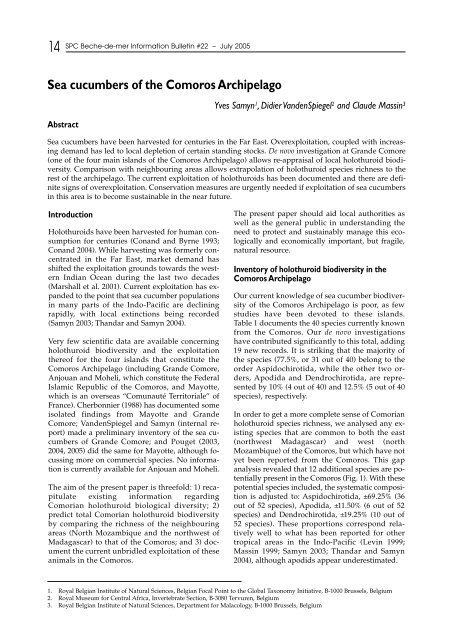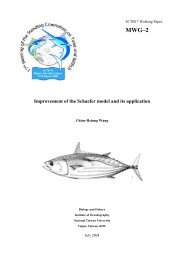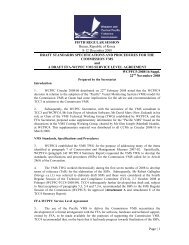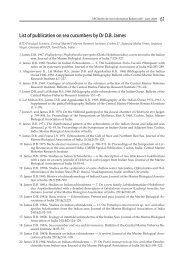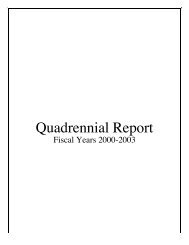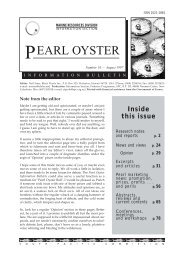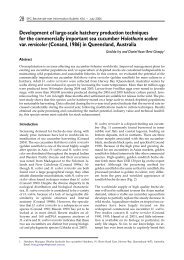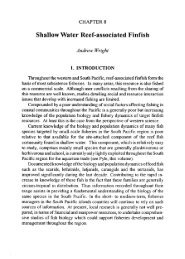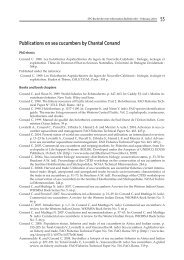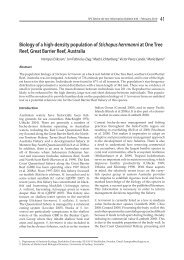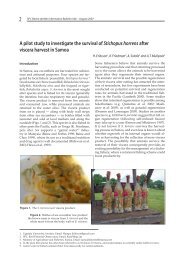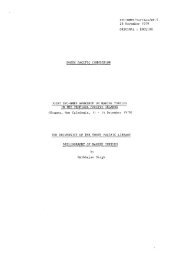Sea cucumbers of the Comoros Archipelago
Sea cucumbers of the Comoros Archipelago
Sea cucumbers of the Comoros Archipelago
Create successful ePaper yourself
Turn your PDF publications into a flip-book with our unique Google optimized e-Paper software.
14<br />
SPC Beche-de-mer Information Bulletin #22 – July 2005<br />
<strong>Sea</strong> <strong>cucumbers</strong> <strong>of</strong> <strong>the</strong> <strong>Comoros</strong> <strong>Archipelago</strong><br />
Abstract<br />
Introduction<br />
Holothuroids have been harvested for human consumption<br />
for centuries (Conand and Byrne 1993;<br />
Conand 2004). While harvesting was formerly concentrated<br />
in <strong>the</strong> Far East, market demand has<br />
shifted <strong>the</strong> exploitation grounds towards <strong>the</strong> western<br />
Indian Ocean during <strong>the</strong> last two decades<br />
(Marshall et al. 2001). Current exploitation has expanded<br />
to <strong>the</strong> point that sea cucumber populations<br />
in many parts <strong>of</strong> <strong>the</strong> Indo-Pacific are declining<br />
rapidly, with local extinctions being recorded<br />
(Samyn 2003; Thandar and Samyn 2004).<br />
Very few scientific data are available concerning<br />
holothuroid biodiversity and <strong>the</strong> exploitation<br />
<strong>the</strong>re<strong>of</strong> for <strong>the</strong> four islands that constitute <strong>the</strong><br />
<strong>Comoros</strong> <strong>Archipelago</strong> (including Grande Comore,<br />
Anjouan and Moheli, which constitute <strong>the</strong> Federal<br />
Islamic Republic <strong>of</strong> <strong>the</strong> <strong>Comoros</strong>, and Mayotte,<br />
which is an overseas “Comunauté Territoriale” <strong>of</strong><br />
France). Cherbonnier (1988) has documented some<br />
isolated findings from Mayotte and Grande<br />
Comore; VandenSpiegel and Samyn (internal report)<br />
made a preliminary inventory <strong>of</strong> <strong>the</strong> sea <strong>cucumbers</strong><br />
<strong>of</strong> Grande Comore; and Pouget (2003,<br />
2004, 2005) did <strong>the</strong> same for Mayotte, although focussing<br />
more on commercial species. No information<br />
is currently available for Anjouan and Moheli.<br />
The aim <strong>of</strong> <strong>the</strong> present paper is threefold: 1) recapitulate<br />
existing information regarding<br />
Comorian holothuroid biological diversity; 2)<br />
predict total Comorian holothuroid biodiversity<br />
by comparing <strong>the</strong> richness <strong>of</strong> <strong>the</strong> neighbouring<br />
areas (North Mozambique and <strong>the</strong> northwest <strong>of</strong><br />
Madagascar) to that <strong>of</strong> <strong>the</strong> <strong>Comoros</strong>; and 3) document<br />
<strong>the</strong> current unbridled exploitation <strong>of</strong> <strong>the</strong>se<br />
animals in <strong>the</strong> <strong>Comoros</strong>.<br />
Yves Samyn 1 , Didier VandenSpiegel 2 and Claude Massin 3<br />
<strong>Sea</strong> <strong>cucumbers</strong> have been harvested for centuries in <strong>the</strong> Far East. Overexploitation, coupled with increasing<br />
demand has led to local depletion <strong>of</strong> certain standing stocks. De novo investigation at Grande Comore<br />
(one <strong>of</strong> <strong>the</strong> four main islands <strong>of</strong> <strong>the</strong> <strong>Comoros</strong> <strong>Archipelago</strong>) allows re-appraisal <strong>of</strong> local holothuroid biodiversity.<br />
Comparison with neighbouring areas allows extrapolation <strong>of</strong> holothuroid species richness to <strong>the</strong><br />
rest <strong>of</strong> <strong>the</strong> archipelago. The current exploitation <strong>of</strong> holothuroids has been documented and <strong>the</strong>re are definite<br />
signs <strong>of</strong> overexploitation. Conservation measures are urgently needed if exploitation <strong>of</strong> sea <strong>cucumbers</strong><br />
in this area is to become sustainable in <strong>the</strong> near future.<br />
The present paper should aid local authorities as<br />
well as <strong>the</strong> general public in understanding <strong>the</strong><br />
need to protect and sustainably manage this ecologically<br />
and economically important, but fragile,<br />
natural resource.<br />
Inventory <strong>of</strong> holothuroid biodiversity in <strong>the</strong><br />
<strong>Comoros</strong> <strong>Archipelago</strong><br />
Our current knowledge <strong>of</strong> sea cucumber biodiversity<br />
<strong>of</strong> <strong>the</strong> <strong>Comoros</strong> <strong>Archipelago</strong> is poor, as few<br />
studies have been devoted to <strong>the</strong>se islands.<br />
Table 1 documents <strong>the</strong> 40 species currently known<br />
from <strong>the</strong> <strong>Comoros</strong>. Our de novo investigations<br />
have contributed significantly to this total, adding<br />
19 new records. It is striking that <strong>the</strong> majority <strong>of</strong><br />
<strong>the</strong> species (77.5%, or 31 out <strong>of</strong> 40) belong to <strong>the</strong><br />
order Aspidochirotida, while <strong>the</strong> o<strong>the</strong>r two orders,<br />
Apodida and Dendrochirotida, are represented<br />
by 10% (4 out <strong>of</strong> 40) and 12.5% (5 out <strong>of</strong> 40<br />
species), respectively.<br />
In order to get a more complete sense <strong>of</strong> Comorian<br />
holothuroid species richness, we analysed any existing<br />
species that are common to both <strong>the</strong> east<br />
(northwest Madagascar) and west (north<br />
Mozambique) <strong>of</strong> <strong>the</strong> <strong>Comoros</strong>, but which have not<br />
yet been reported from <strong>the</strong> <strong>Comoros</strong>. This gap<br />
analysis revealed that 12 additional species are potentially<br />
present in <strong>the</strong> <strong>Comoros</strong> (Fig. 1). With <strong>the</strong>se<br />
potential species included, <strong>the</strong> systematic composition<br />
is adjusted to: Aspidochirotida, ±69.25% (36<br />
out <strong>of</strong> 52 species), Apodida, ±11.50% (6 out <strong>of</strong> 52<br />
species) and Dendrochirotida, ±19.25% (10 out <strong>of</strong><br />
52 species). These proportions correspond relatively<br />
well to what has been reported for o<strong>the</strong>r<br />
tropical areas in <strong>the</strong> Indo-Pacific (Levin 1999;<br />
Massin 1999; Samyn 2003; Thandar and Samyn<br />
2004), although apodids appear underestimated.<br />
1. Royal Belgian Institute <strong>of</strong> Natural Sciences, Belgian Focal Point to <strong>the</strong> Global Taxonomy Initiative, B-1000 Brussels, Belgium<br />
2. Royal Museum for Central Africa, Invertebrate Section, B-3080 Tervuren, Belgium<br />
3. Royal Belgian Institute <strong>of</strong> Natural Sciences, Department for Malacology, B-1000 Brussels, Belgium
SPC Beche-de-mer Information Bulletin #22 – July 2005 15<br />
Table 1. Shallow water holothuroids documented from <strong>the</strong> <strong>Comoros</strong> <strong>Archipelago</strong>. Pers. observ. means species<br />
was collected by our team in 2003 or 2004.<br />
Taxon Reference Taxon Reference<br />
APODIDA Brandt, 1835<br />
Chiridotidae Oestergren, 1898<br />
Polycheira fusca (Quoy &<br />
Gaimard, 1833)<br />
Synaptidae Oestergren, 1898<br />
Euapta godeffroyi (Semper,<br />
1868)<br />
Synapta maculata (Chamisso<br />
& Eysenhardt, 1821)<br />
H. (Metriatyla) scabra Jaeger,<br />
1833<br />
H. (Micro<strong>the</strong>le) fuscogilva<br />
Cherbonnier, 1980<br />
Cherbonnier, 1988 H. (M.) fuscopunctata Jaeger,<br />
1833<br />
Pouget 2003, 2004, 2005<br />
pers. observ.<br />
Pouget 2004; pers. observ.<br />
H. (M.) nobilis (Selenka, 1867) Pouget 2003, 2004, 2005;<br />
pers. observ.<br />
pers. observ. H. (Platyperona) difficilis<br />
Semper, 1868<br />
pers. observ.<br />
pers. observ. H. (Selenkothuria) parva<br />
Krauss in Lampert, 1885<br />
Cherbonnier1988<br />
Synaptula recta (Semper, 1868) pers. observ. H. (Stauropora) pervicax<br />
Selenka, 1867<br />
ASPIDOCHIROTIDA Grube, 1840<br />
H. (Theelothuria) maculosa<br />
Pearson, 1913<br />
Holothuriidae Ludwig, 1894<br />
H. (Thymiosycia) impatiens<br />
(Forskål, 1775)<br />
Actinopyga sp. pers. observ. Pearsonothuria graeffei<br />
(Semper, 1868)<br />
A. echinites (Jaeger, 1833) Pouget 2004<br />
A. mauritiana (Quoy &<br />
Gaimard, 1833)<br />
A. miliaris (Quoy & Gaimard,<br />
1833)<br />
Cherbonnier 1988; Pouget<br />
2003, 2005; pers. observ.<br />
A. obesa (Selenka, 1867) Cherbonnier 1988; pers. observ.<br />
Bohadschia atra Massin et al.,<br />
1999<br />
B. cousteaui Cherbonnier,<br />
1954<br />
B. marmorata Jaeger, 1833 pers. observ.<br />
Stichopodidae Haeckel, 1896<br />
Stichopus chloronotus Brandt,<br />
1835<br />
Cherbonnier 1988<br />
pers. observ.<br />
Cherbonnier 1988<br />
pers. observ. S. hermanni Semper, 1868 pers. observ.<br />
Cherbonnier 1988; Pouget<br />
2005; pers. observ.<br />
S. horrens Selenka, 1867 pers. observ.<br />
Thelenota ananas (Jaeger,<br />
1833)<br />
Cherbonnier, 1988; pers. observ.<br />
Cherbonnier 1988; Pouget<br />
2003, 2004, 2005; pers. obs.<br />
Pouget 2003, 2004, 2005;<br />
pers. observ.<br />
pers. observ. T. anax H.L. Clark, 1921 pers. observ.<br />
DENDROCHIROTIDA<br />
B. subrubra (Quoy & Gaimard,<br />
1833)<br />
Pouget 2005; pers. observ.<br />
Cucumariidae Ludwig, 1894<br />
B. vitiensis (Semper, 1868) Pouget 2003, 2004, 2005 Pentacta tesselara<br />
Cherbonnier, 1970<br />
pers. observ.<br />
Holothuria (Halodeima) atra Pouget 2003, 2005; pers. ob- Havelockia turrispinea Cherbonnier1988<br />
Jaeger, 1833<br />
serv.<br />
Cherbonnier, 1988<br />
H. (Lessonothuria) hawaiiensis<br />
Fisher, 1907<br />
pers. observ.<br />
Phyllophoridae Oestergren, 1907<br />
H. (L.) pardalis Selenka, 1867 Cherbonnier, 1988; pers. ob- Thyone comata Cherbonnier, Cherbonnier1988<br />
serv.<br />
1988<br />
H. (L.) verrucosa Selenka, 1867 pers. observ.<br />
Sclerodactylidae Panning, 1949<br />
H. (Mertensiothuria) hilla<br />
Lesson, 1830<br />
H. (M.) leucospilota (Brandt,<br />
1835)<br />
pers. observ. Afrocucumis africana (Semper,<br />
1868)<br />
Cherbonnier1988; pers. observ.<br />
Ohshimella ehrenbergi<br />
(Selenka, 1867)<br />
pers. observ.<br />
pers. observ.
16<br />
SPC Beche-de-mer Information Bulletin #22 – July 2005<br />
Figure 1. Gap analysis indicating potential <strong>Comoros</strong><br />
<strong>Archipelago</strong> holothuriod species. Such gap analysis is<br />
appropriate given <strong>the</strong> fact that <strong>the</strong> northwest Madagascar<br />
Current connects <strong>the</strong> west coast <strong>of</strong> Madagascar with<br />
mainland Africa (Mozambique); <strong>the</strong> <strong>Comoros</strong> are situated<br />
between <strong>the</strong> latter areas, and <strong>the</strong> archipelago’s fauna should<br />
resemble that <strong>of</strong> <strong>the</strong> areas to <strong>the</strong> west and east (see Thandar<br />
and Samyn 2004 for <strong>the</strong> oceanography <strong>of</strong> <strong>the</strong> region).<br />
Exploitation <strong>of</strong> sea <strong>cucumbers</strong> in <strong>the</strong><br />
<strong>Comoros</strong> <strong>Archipelago</strong><br />
1. Harvesting from <strong>the</strong> wild<br />
The first national strategy and action<br />
plan for <strong>the</strong> conservation <strong>of</strong> biological diversity<br />
<strong>of</strong> <strong>the</strong> Federal Islamic Republic <strong>of</strong><br />
<strong>the</strong> <strong>Comoros</strong> (2000, see http://www.biodiv.org/world/map.asp)<br />
contained an<br />
interesting account <strong>of</strong> <strong>the</strong> country’s sea<br />
cucumber resources. This legal document<br />
concisely mentions <strong>the</strong> dangers associated<br />
with unbridled exploitation <strong>of</strong><br />
sea cucumber stocks. More recently,<br />
VandenSpiegel and Samyn (internal report)<br />
expressed <strong>the</strong>ir concern that excessive<br />
exploitation <strong>of</strong> this fragile resource<br />
would inevitably lead to depletion. A recent<br />
survey by <strong>the</strong> latter authors, aided<br />
by one <strong>of</strong> us (CM) as well as a local<br />
NGO (AIDE, Association pour l’Intervention<br />
et le Développement de l’Environnement)<br />
and <strong>the</strong> responsible governmental<br />
ministry (DGE, Département<br />
Général de l’Environnement), came to<br />
<strong>the</strong> same conclusion.<br />
As in <strong>the</strong> whole <strong>of</strong> <strong>the</strong> Indo-Pacific, <strong>the</strong><br />
most sought-after species belong to<br />
Aspidochirotida. Target species include<br />
Holothuriidae [several Actinopyga spp.,<br />
Holothuria (Micro<strong>the</strong>le) fuscogilva Cherbonnier,<br />
1980, H. (M.) nobilis (Selenka,<br />
1867)] and Stichopodidae [Stichopus<br />
chloronotus Brandt, 1835, Thelenota ananas<br />
(Jaeger, 1833) and T. anax H.L. Clark, 1921]<br />
(Fig. 2).<br />
We note that abundance <strong>of</strong> several <strong>of</strong> <strong>the</strong><br />
above mentioned species appears to have<br />
decreased from November 2003 to October<br />
2004, although at present this observation<br />
cannot be supported with hard data.<br />
2. Processing into beche-de-mer<br />
The process used to prepare species for <strong>the</strong><br />
beche-de-mer trade is a simplified version<br />
<strong>of</strong> <strong>the</strong> process used throughout <strong>the</strong> Indo-<br />
Pacific (Conand 1990). Freshly collected<br />
specimens are gutted with a longitudinal<br />
incision, boiled for one hour, and dried in<br />
<strong>the</strong> sun. Contrary to o<strong>the</strong>r regions, <strong>the</strong><br />
body wall <strong>of</strong> <strong>the</strong> specimens is not scraped<br />
to remove excessive ossicles. Burrowing <strong>of</strong><br />
treated specimens in order to speed <strong>the</strong><br />
process is also not carried out. Figures 4<br />
and 5 illustrate <strong>the</strong> processing technique<br />
for some <strong>of</strong> <strong>the</strong> harvested species.<br />
Figure 2. Commercial species belonging to <strong>the</strong> order Aspidochirotida.<br />
At Grande Comore, <strong>the</strong> main harvested species are: A) Holothuria<br />
(Micro<strong>the</strong>le) fuscogilva Cherbonnier, 1980; B) Holothuria (Micro<strong>the</strong>le)<br />
nobilis (Selenka, 1867); C) Thelenota ananas (Jaeger, 1833); and , D)<br />
Thelenota anax H.L. Clark, 1921.<br />
Images: A by B. Van Bogaert; B by T. Schils;<br />
and C and D by D. VandenSpiegel
3. Farming as a sustainable approach<br />
Chinese immigrants control <strong>the</strong> harvesting and<br />
processing <strong>of</strong> sea <strong>cucumbers</strong> in <strong>the</strong> <strong>Comoros</strong>.<br />
They have <strong>the</strong> expertise to process sea <strong>cucumbers</strong><br />
into an exportable commercial product, and are<br />
aware <strong>of</strong> <strong>the</strong> significant retail value. Interviews<br />
with fishermen, Comorian environmental authorities<br />
and policy makers, in addition to personal<br />
observations, however, indicate that sea <strong>cucumbers</strong><br />
are currently exploited in a detrimental manner.<br />
Various observations support this conclusion:<br />
1) some high value commercial species such as<br />
Holothuria scabra were not found, even though<br />
some ideal habitats were encountered during our<br />
SPC Beche-de-mer Information Bulletin #22 – July 2005 17<br />
surveys; 2) seagrass beds at Grande Comore are<br />
nearly devoid <strong>of</strong> sea <strong>cucumbers</strong>; 3) densities <strong>of</strong><br />
species appear to have dropped since our first<br />
survey in November 2003; 4) fishing is done at<br />
ever increasing depths (scuba divers now readily<br />
descend to 70 m or more); 5) some processed specimens<br />
are so small that <strong>the</strong>y will fail to satisfy <strong>the</strong><br />
retail market in <strong>the</strong> Far East; and 6) high as well as<br />
low value species are processed.<br />
Fortunately, <strong>the</strong>re is some positive news. Chinese<br />
fishermen, fully aware <strong>of</strong> <strong>the</strong>ir destructive fishing<br />
activities, have recently begun farming some <strong>of</strong> <strong>the</strong><br />
high value species. We hope <strong>the</strong>y will be successful<br />
in <strong>the</strong>ir initiative.<br />
Figure 3. Freshly gutted specimens <strong>of</strong> A) Holothuria (Micro<strong>the</strong>le) fuscogilva Cherbonnier, 1980;<br />
B) Thelenota anax Clark, 1921; and C) an as yet undescribed color morph <strong>of</strong> Holothuria<br />
(Micro<strong>the</strong>le) nobilis (Selenka, 1867). All images by D. VandenSpiegel<br />
Figure 4. After gutting, specimens are boiled for one hour (A) and dried in <strong>the</strong> sun (B, C).<br />
Image A & C by D. VandenSpiegel, B by A. Soifa<br />
Figure 5. Achieving durability in sea cucumber exploitation through farming initiatives. A) Tank for rearing sea<br />
<strong>cucumbers</strong>; B) Holothuria (Micro<strong>the</strong>le) nobilis (Selenka, 1867); and C) Thelenota ananas (Jaeger, 1833).<br />
All images by D. VandenSpiegel
18<br />
SPC Beche-de-mer Information Bulletin #22 – July 2005<br />
Towards sustainable exploitation <strong>of</strong> Comoran<br />
sea <strong>cucumbers</strong><br />
In early 2003, <strong>the</strong> Government <strong>of</strong> <strong>the</strong> Federal<br />
Islamic Republic <strong>of</strong> <strong>the</strong> <strong>Comoros</strong> sought <strong>the</strong> assistance<br />
<strong>of</strong> Belgian specialists to train local scientists in<br />
sea cucumber identification and fishery management.<br />
Such education was indeed urgently needed,<br />
as exploitation by (predominantly) Chinese fishermen<br />
was pushing local stocks to extinction.<br />
Financially supported by <strong>the</strong> Commission de l’Océan<br />
Indien (COI) and <strong>the</strong> Belgian Development<br />
Cooperation (DGDC), we have responded by documenting<br />
<strong>the</strong> sea cucumber biodiversity <strong>of</strong> <strong>the</strong><br />
<strong>Comoros</strong> through de novo sampling as well as by reviewing<br />
already existing museum collections. In addition,<br />
with <strong>the</strong> fur<strong>the</strong>r support <strong>of</strong> <strong>the</strong> Belgian<br />
Development Cooperation, we trained two local scientists<br />
in <strong>the</strong> taxonomy and monitoring <strong>of</strong> sea <strong>cucumbers</strong>,<br />
equipped a laboratory with basic infrastructure<br />
and appropriate literature, and established<br />
a reference collection. These actions have allowed<br />
<strong>the</strong> establishment <strong>of</strong> a “Point focal holothuries” that<br />
is housed at <strong>the</strong> NGO AIDE in Moroni (<strong>Comoros</strong>).<br />
Conclusion<br />
The holothuroid fauna <strong>of</strong> <strong>the</strong> shallow Comoran<br />
waters was poorly known prior to our studies,<br />
which have expanded <strong>the</strong> number <strong>of</strong> known<br />
species <strong>of</strong> sea <strong>cucumbers</strong> from 22 to 40.<br />
Fur<strong>the</strong>rmore, gap analysis allowed <strong>the</strong> prediction<br />
<strong>of</strong> 12 additional species. Total shallow water<br />
holothuroid species richness thus seems to average<br />
around 50 species. Until all four islands <strong>of</strong> <strong>the</strong><br />
<strong>Comoros</strong> have been adequately sampled, however,<br />
this figure should be viewed as an underestimate.<br />
We take this opportunity to express our deepest<br />
concern in regard to <strong>the</strong> present, ra<strong>the</strong>r blind, overexploitation<br />
<strong>of</strong> sea <strong>cucumbers</strong> in <strong>the</strong> <strong>Comoros</strong>.<br />
Acknowledgements<br />
This investigation was carried out at <strong>the</strong> request <strong>of</strong><br />
<strong>the</strong> “Département Général de l’Environnement”, <strong>the</strong><br />
responsible Ministry <strong>of</strong> <strong>the</strong> Federal Islamic Republic<br />
<strong>of</strong> <strong>the</strong> <strong>Comoros</strong>. This Ministry, through Mrs<br />
F. Abdalah, in joint cooperation with <strong>the</strong> NGO<br />
AIDE, through Mr A. Soifa and Mr A. Said, and <strong>the</strong><br />
CNDRS, through Mr. M. Bachirou, proved indispensable<br />
in providing logistical support. Financial<br />
support was provided for sampling in <strong>the</strong> <strong>Comoros</strong><br />
(2003) from <strong>the</strong> Commission de l’Océan Indien (project<br />
number COI/FED/03/025), and later (2004) from<br />
<strong>the</strong> Belgian Development Cooperation (through <strong>the</strong><br />
specific framework project MRAC RAF72, as well as<br />
<strong>the</strong> Belgian Focal Point to <strong>the</strong> Global Taxonomy<br />
Initiative) and <strong>the</strong> Department <strong>of</strong> Invertebrates <strong>of</strong><br />
<strong>the</strong> RBINS. This research would have been impossible<br />
without <strong>the</strong> kind help <strong>of</strong> “Itsandra Plongée”, <strong>the</strong><br />
Grande Comore-based dive club. Karin’s and later<br />
Philippe’s help proved indispensable for locating<br />
appropriate sampling sites. Finally, we wish to<br />
thank Danny for never failing to pick us up from <strong>the</strong><br />
swell <strong>of</strong> <strong>the</strong> Indian Ocean.<br />
References<br />
Cherbonnier G. 1988. Echinodermes: Holothurides.<br />
Faune de Madagscar 70:1–292.<br />
Conand C. 1990. The fishery resources <strong>of</strong> Pacific<br />
Island countries. Part 2. Holohturians. FAO<br />
Fisheries Technical Paper 272.2. Rome. 108 p.<br />
Conand C. 2004. Present status <strong>of</strong> world sea cucumber<br />
resources and utilisation: an international<br />
overview. FAO Fisheries Technical<br />
Paper 463:13–23.<br />
Conand C. and Byrne M. 1993. A review <strong>of</strong> recent<br />
developments in <strong>the</strong> world sea cucumber fisheries.<br />
Marine Fisheries Review 55:1–13.<br />
Levin V.S. 1999. Feeding by shallow-water<br />
holothuroids (Echinodermata) and its effect on<br />
<strong>the</strong> environment. Lawrence J.M. (ed.).<br />
Polytechnica, Saint-Petersburg. 254 p.<br />
Marshall N., Milledge S.A.H. and Afonso P.S. 2001.<br />
Stormy <strong>Sea</strong>s for Marine Invertebrates – Trade<br />
in <strong>Sea</strong> Cucumbers, <strong>Sea</strong>shells and Lobsters in<br />
Kenya, Tanzania and Mozambique. TRAFFIC<br />
East Sou<strong>the</strong>rn Africa, Kenya. 70 p.<br />
Massin C. 1999. Reef-dwelling Holothuroidea<br />
(Echinodermata) <strong>of</strong> <strong>the</strong> Spermonde <strong>Archipelago</strong><br />
(South-West Sulawesi, Indonesia).<br />
Zoologische Verhandelingen 329:1–144.<br />
Pouget A. 2003. Etude sur l’exploitation des<br />
holothuries à Mayotte et évaluation du stock<br />
exploitable sur le récif frangeant. Rapport de<br />
stage. Services de Pêches et de<br />
l’Environnement Marin de Mayotte (DAF),<br />
39 p. + annexes.<br />
Pouget A. 2004. <strong>Sea</strong> cucumber fisheries in <strong>the</strong><br />
Mayotte reef system, Indian Ocean. SPC<br />
Beche-de-mer Information Bulletin 19:35–38.<br />
Pouget A. 2005. Abundance and distribution <strong>of</strong><br />
holothurians on <strong>the</strong> fringing reef flats <strong>of</strong><br />
Grande Terre, Mayotte, Indian Ocean. SPC<br />
Beche-de-mer Information Bulletin 21:22–26.<br />
Samyn Y. 2003. Shallow-water Holothuroidea<br />
(Echinodermata) from Kenya and Pemba<br />
Island (Tanzania). Studies in Afrotropical<br />
Zoology 292:1–158.<br />
Thandar A.S. and Samyn Y. 2004. Shallow-water<br />
holothuroid (Echinodermata: Holothuroidea)<br />
biodiversity and biogeography <strong>of</strong> <strong>the</strong> subtropical<br />
east coast <strong>of</strong> South Africa. In: Heinzeller &<br />
Nebelsick (eds), Echinoderms: München,<br />
Taylor & Francis Group, London. 253–260.


